Hanna Marie Dean Wright, our Artist of the Month, is a self-taught folk artist from Keavy, Kentucky, who also teaches special education to school children. Known for her “Starmen” series, Hanna enjoys painting abstract figures and faces on reclaimed wooden panels. She has already created over 2000 works on paper and over 400 paintings, and her work has been displayed in galleries from Australia to New Mexico.
The Antonym caught up with Hanna Wright for a deeper understanding of her work and American folk art in general.
Atrayee: You call yourself a self-taught painter. When did you decide on becoming an artist, and a folk artist at that?
Hanna: I have been creating art since I was old enough to hold a crayon. I grew up admiring the artwork that my mamaw, folk artist Geraldine Scalf of Barbourville, Kentucky would create. As a young child I learned that with a creative mind, nearly anything can be an art supply. Creating unique works of art on rocks, scrap wood, and thrift store furniture is more fulfilling to me than using professional art supplies.
Atrayee: Why did you choose folk art? What does it inspire in you?
Hanna: I don’t think I really made the choice to do folk art. My artwork just so happens to be considered folk art due to the area I live in, the resources I use, and the experiences I’ve shared. I did not go to college to learn about art. I became more serious about my art in 2015 when I graduate college and became a teacher. Art became my main hobby and a therapy for stress in my adult life. Art has kept me sane during the pandemic. Art inspires me to keep reaching for success in the art world. As a self-taught artist I feel that I have nothing to lose. When your future is uncertain, every opportunity becomes important.
Atrayee: I see where you’re coming from. You seem to rely on bold colors, which is a hallmark of the folk tradition. What do you think your striking palette lends to your art?
Hanna: Bold colors allow me to expand on the expressions I try to express through my abstract portraits. Cool colors are typically used to represent more soothing and compassionate expressions. Warm colors are used to represent love, seriousness, or even anger. I choose colors that just “feel right” when used together. Having no artistic educational background allows me to be freer with color choice and rely on my personal intuition.
Atrayee: Let us talk about your subjects—usually larger-than-life abstract portraits. Do they in any way symbolize your personal history? What do you want them to communicate?
Hanna: I believe my abstract portraits represent emotions felt by the average person on any given day. They symbolize a wide range of emotions. Empathetic viewers of my artwork can relate to these expressions and pick up on my emotions when they see my art. I like hearing what expressions viewers think of when they see my abstract portraits.
Atrayee: What materials and medium do you prefer?
Hanna: I mostly use ink on paper. I also enjoy using acrylic and household paints on wood panels. I most enjoy working on found materials like scrap wood.
Atrayee: Let’s talk about American folk art. What does American folk art, and folk paintings in particular, mean to you? While it has an extremely rich history, what do you think its future looks like, both in terms of quality and market value?
Hanna: In my opinion, folk art truly represents an artist’s freedom of expression. Folk art allows people to see beauty in an unconventional raw format. I see folk art becoming a premier focus for collectors this century. Technology has allowed folk artists to reach a much wider audience than ever before. I believe folk artists who share their work online will find it easier to break into the art world.
Atrayee: That gives me a lot of hope! It’s time we integrated folk art into the so-called mainstream, and had a level playing field for all kinds of art. So Hanna, does teaching special education in school propel your creativity, or do you think they are entirely separate worlds?
Hanna: Teaching special education classes has allowed me to meet a vast range of people. My students and I can be eccentric at times. I like to incorporate art into my lesson plans anytime there is an opportunity. As a special education geometry teacher, I enjoy teaching students how to draw two- and three-dimensional geometric figures.
My students know about my artwork and will sometimes ask to see what I have been working on. Many of my students are also interested in artwork and many have joined the school drawing club that I sponsor.
Atrayee: You grew up in southern Kentucky and continue to live and work there. Does the physical or cultural landscape of the region influence your paintings? If so, how does it feature in your work?
Hanna: I really enjoy the southeastern Kentucky culture. I wouldn’t want to be anywhere else in the world. Although digital art has become more popular in recent years, I can’t say that I am a fan. I prefer art that has been made by hand and I will only create art by hand. I have no interest in learning about digital art. Traditional art will always be the strongest art form in my area because technology-based art forms are not frequently talked about.
I think technology barriers in my area allow me and other local artists to be more creative, yet lesser known to the rest of the art world. Kentucky will always hold a special place in my heart.
__
Abstract Portraits , Ink on Paper

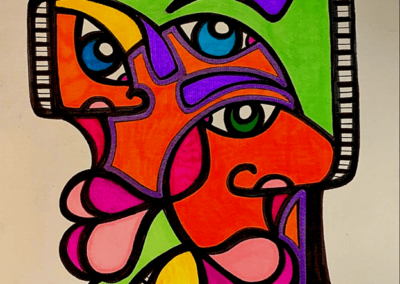
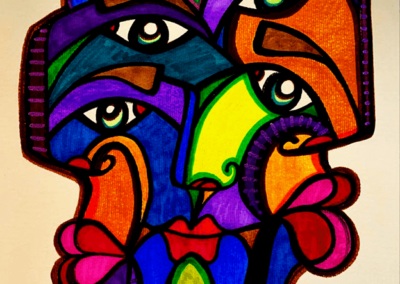
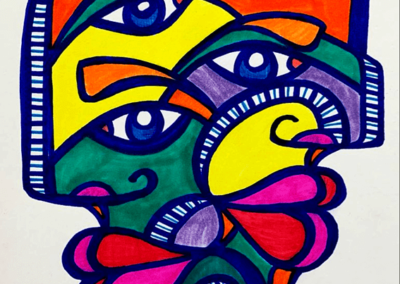
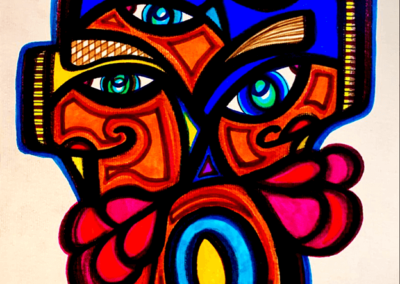
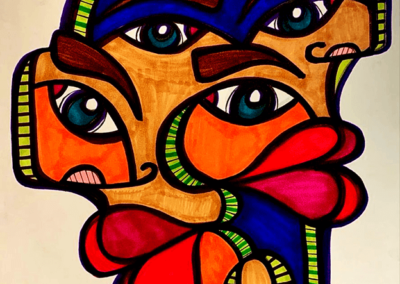
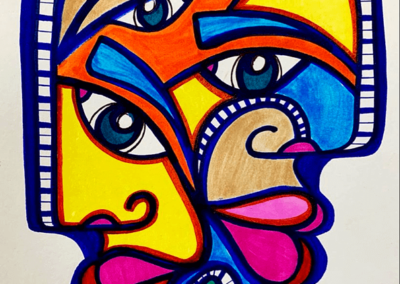
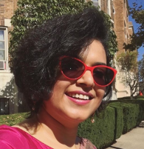
























0 Comments